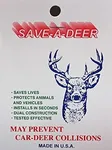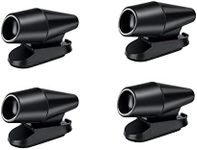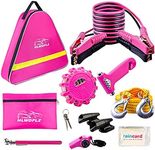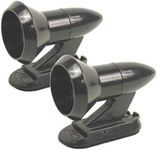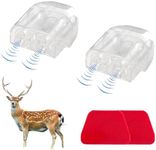Buying Guide for the Best Deer Whistles
Choosing the right deer whistle for your vehicle is about understanding how these small devices work and what features matter most for your safety and peace of mind. Deer whistles are designed to emit a sound, often ultrasonic, that is intended to alert deer and other wildlife to your approaching vehicle, potentially reducing the risk of collisions. While their effectiveness is debated, many drivers use them as an extra precaution, especially in areas with high wildlife activity. When shopping for a deer whistle, focus on the key specifications that influence how well the device might perform and how easy it is to use and maintain.Sound FrequencySound frequency refers to the pitch of the sound the whistle emits, usually measured in kilohertz (kHz). This is important because deer and other animals hear at different frequencies than humans. Most deer whistles are designed to produce ultrasonic sounds, which are above the range of human hearing but within the hearing range of deer. Some models emit both audible and ultrasonic sounds. If you want a whistle that you can't hear but is still effective for wildlife, look for ultrasonic-only models. If you prefer to know it's working by hearing a faint sound, choose one with an audible component. Your choice should depend on your comfort with hearing the whistle and your belief in the effectiveness of ultrasonic versus audible alerts.
Mounting MethodThe mounting method describes how the deer whistle attaches to your vehicle, such as adhesive tape, screws, or clips. This matters because a secure attachment ensures the whistle stays in place at high speeds and in various weather conditions. Adhesive mounts are easy to install and remove, making them suitable for most users who want a quick setup. Screw or clip mounts offer a more permanent solution but may require tools and a bit more effort. Consider how often you might want to remove or reposition the whistle, and whether you are comfortable with minor vehicle modifications.
Material QualityMaterial quality refers to what the deer whistle is made of, such as plastic or metal. This is important for durability, especially since the device will be exposed to the elements, including rain, snow, and road debris. Higher-quality materials are less likely to crack, fade, or break over time. If you drive frequently or in harsh weather, look for whistles made from UV-resistant and weatherproof materials. If you only need the whistle for occasional use, standard plastic may suffice.
Size and DesignSize and design relate to how large or small the whistle is and how it looks on your vehicle. This matters for both aesthetics and effectiveness, as some designs are more aerodynamic and less likely to create wind noise or drag. Smaller, low-profile whistles are less noticeable and may blend in better with your vehicle, while larger ones might be more visible but could be more effective at producing sound. Choose a size and design that fits your vehicle and your preference for visibility versus subtlety.
Ease of MaintenanceEase of maintenance refers to how simple it is to clean and check the whistle for blockages or damage. Since debris, insects, or dirt can clog the whistle and reduce its effectiveness, it's important to choose a model that you can easily inspect and clean. Some whistles have removable covers or are designed to be rinsed out quickly. If you want a low-maintenance option, look for whistles that advertise easy cleaning or self-cleaning features.

